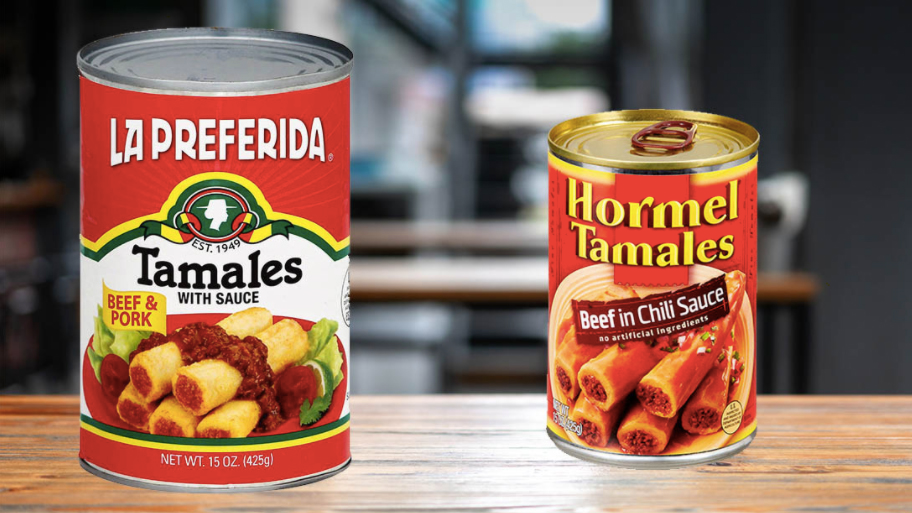When You Crave A Tamale, Even The Canned Version Will Do
I grew up with parents who tended not to experiment much with new foods. As a result, I never had a tamale until my mid-20s. Over the last 15 years, I don't think I've sought out or enjoyed any other food more.
I ate that first tamale at the Cork Lounge, a dive bar on the north side of Chicago. This is a bar that does not serve food, but it was on the route for the Tamale Guy, a fifth-tier Chicago celebrity on par with the Cubs superfan Ronnie "Woo Woo" Wickers or Ray St. Ray, the singing cabdriver. It was during an evening of oat soda enjoyment with my friends that he appeared with his Lil' Oscar full of tamales. I was in an experimenting state of mind, so I bought a Ziploc bag of five tamales with a side of salsa in a small plastic cup. Five dollars and five minutes later, they were all gone. I may have eaten the napkins for all I know.
From then on I became a tamale fiend. On nights when the Tamale Guy never appeared at the Cork, I went across the street to Burrito House, a place that served okay tamales in a no-frills setting. Tamales became my default order whenever they appeared on a menu. My wife and I eventually started a tradition of making several dozen from scratch each year during Christmas, a day-long labor of love that stocks our pantry for at least a month.
When I discovered canned tamales at the grocery store, I was initially skeptical but fascinated. This happened probably 12 years ago; I was living alone, so I could avoid any potential food-shaming from roommates or my spouse-to-be. I'm glad I went for it. Like the adage about how there's no such thing as a bad sandwich, there's no such thing as a bad tamale—even if it comes in a can. I've only had Hormel and La Preferida, which are the only brands available where I shop. Neither one is markedly better, so both are pretty safe bets.
Here are my criteria for a good tamale: first and foremost, it shouldn't be dry. The tamale should have enough body to remain intact, but soft enough to fall apart when prodded by a utensil. It should be tender enough for a toddler. The interior filling shouldn't be too coarse; if it's meat-based, there should be no sizable chunks. There should be a salty, chile-driven spice that permeates the entire bite. And the side sauce shouldn't overshadow the tamale itself.

If you can look past the vessel and stigma of canned meals (e.g. SPAM), the canned tamale satisfies most of these criteria. It's slightly more mushy, but not to the point of full disintegration. Sure, the meat is a little less toothsome, but there is enough textural difference between it and its masa mantle. The chili sauce that drowns the tamale is pretty soupy, but it's thin enough to avoid having too much of it. Having chili (not chile) sauce instead of more traditional enchilada sauce or salsa is peculiar, but it doesn't taste bad. It fulfills enough of my criteria to pass the tamale test, which frankly is enough to make it enjoyable.
Cost-wise, at around $2, a can of tamales is a pretty affordable lunch option. Like Burrito House, it's fast and economical, just at an industrial scale.
There are a few caveats. Taken in isolation, the visual appearance of the tamales fresh from the can isn't something that would grace the cover of Saveur. Canned tamales lack a traditional husk wrapper. Instead they come in Delta-style waxy paper. Unwrapping each tamale from its jacket prior to cooking is like a school Halloween party game (you're unwrapping... brains!) and requires a good hand washing afterwards. The cans suggest simmering the contents over the stove for a few minutes; I say skip it and cook them in the microwave for two minutes.
I think none of these drawbacks are reason enough to forego the guilty pleasure of canned tamales. There may be tamale experts that argue handmade ones are way better. You know what? I agree. They totally are. That doesn't mean logically the cheap mass-produced ones are automatically terrible. They're quick and cheap without sacrificing the essence of a tamale (soft, salty, and spicy). And if you lack access to a decent Mexican restaurant or an entire day to craft them yourself, a can will work fine to satisfy a craving. Sometimes good enough can be good enough, and these are good enough.
